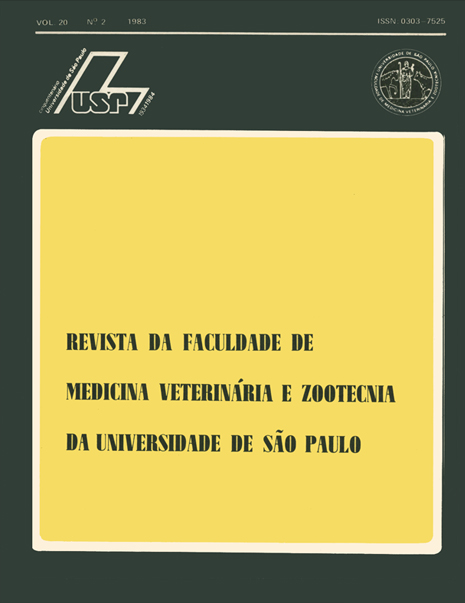Contribution to the study of the arterial vascularization in swine (Landrace breed) kidneys
DOI:
https://doi.org/10.11606/issn.2318-3659.v20i2p129-137Keywords:
Anatomy of swine, Arteries, Kidney, VascularizationAbstract
There were examined 30 pairs of kidneys from Landrace breed (15 adult males and 15 adult females). Animals were provided by the "Centro Intraunidadede Zootecnia e Indústrias Pecuárias Fernando Costa, da Universidade de São Paulo". After reducing the assemblages, there were cannuled and injected the isolated kidney arteries with a "vinyl" solution (bakelite vinyl — Bland VMCH), colored in red and also in yellow, through the ureter being the renal pelvis tooked as reference fo r this study. Following, the organs were placed into a suphuric acid 30% solution in order to obtain first the models to examinate kidney arteries and, second, to construct their schematic patterns. It was concluded that: 1) The kidney arteries in these animals are unique and give two branches, the cranial and caudal (86.7% to the right and 90.0% to the left) or the ventral and dorsal (13.3% do the right and 10.0% to the left). 2) The cranial and caudal branches, give normally three to four collaterals with variations from two to eight. 3) The ventral and dorsal branches give collaterals more frequently: in average, three to four; with variations from one to six. 4) The cranial and caudal branches, and the ventral and dorsal, on the left or on the right are not restricted to their correspondent areas. 5) When present, the cranial and caudal branches, the cranial area to the left and to the right, received contributions from the cranial and caudal branches, with prevalence of the first or only from the dranlal. The caudal portion received collaterals of the cranial and caudal branches with the caudal prevalence to the right and cranial to the left and, more frequently, at both sides only from the caudal branch. 6) When present, the ventral and dorsal branches, in many times, or in the right or in the left, the ventrocaudal areas, received contributions from the ventral and dorsal branches, with prevalence of the first and the dorsocranial from these two branches, with preponderance of the second. The ventrocaudal portions depends only of the dorsal branches or of these and of the ventral branches; the dorsocaudal area by the dorsal branch or from itself and the ventral and with preponderance of the first. 7) The right and left polar areas, of the kidneys received: the cranial collaterals from the cranial branches (86.7%) or ventral (13.3%), to the right, and of the same branches in order (90.0% and 10.0%) to the left; the caudal; from caudal branches (86.7%) or dorsal (13.3%) in the right and respectivelly by this branches (90.0% and 10.0%), in the left. 8) The male and female results statistically analised were not different (P < 0.05) concerning their number, distribution and arteriea supply in the different areas of the kidneys.Downloads
Download data is not yet available.
Downloads
Published
1983-09-15
Issue
Section
BASIC SCIENCES
How to Cite
Contribution to the study of the arterial vascularization in swine (Landrace breed) kidneys. (1983). Revista Da Faculdade De Medicina Veterinária E Zootecnia Da Universidade De São Paulo, 20(2), 129-137. https://doi.org/10.11606/issn.2318-3659.v20i2p129-137


